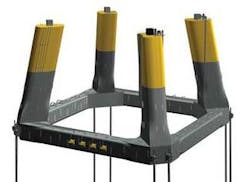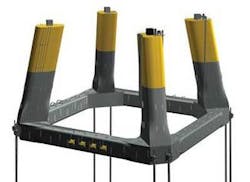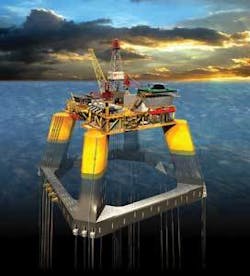FourStar ready for battle
Neil Williams, Homayoun Heidari, Sean Large - SBM Atlantia Inc.
The tension leg platform (TLP) has been a reliable production system for decades. After delivering five such units for the deepwater Gulf of Mexico market -Morpeth, Allegheny, Typhoon, Matterhorn, and most recently Neptune (Offshore June 2007), all based on its SeaStar mono-column design, SBM Atlantia Inc. has developed a new generation TLP system to handle larger payloads than its predecessors and to offer the construction advantage of quayside hull and topsides integration.
The FourStar
Building on the heritage of the SeaStar TLP, SBM Atlantia’s new design was dubbed the “FourStar.” The structure resembles the traditional TLPs used on large deepwater field developments such as Mars, Ursa, and Brutus in that it features four columns set atop a rectangular ring pontoon. The design diverges from the usual in the geometry of its columns.
Whereas traditional TLPs have vertical columns, the four columns of the FourStar are battered toward the center of the platform. Based on a given topsides geometry, this allows the base footprint of the hull, and therefore the water plane moment, to be larger than for conventional vertical column TLP. This provides sufficient stability for quayside integration of the hull and topsides. The structure also is stable enough for towout to the installation site. Moreover, the larger base footprint puts tendon porches further away from the center of the platform to maximize the effective arm of the tendons, leading to a smaller and more economical tendon system.
Designing the TLP
While the FourStar hull is designed to handle both wet- and dry-tree configurations with payloads surpassing 40,000 tons (36,287 metric tons), the system initially was subjected to a front-end engineering and design level study for a typical wet-tree GoM application.
For this environment, the FourStar was designed for a production rate of 100,000 b/d of oil in a typical GoM location in 4,300 ft (1,311 m) of water. The metocean criteria used in the design of the platform was updated using GoM data from hurricanes Ivan, Katrina, and Rita, with a 1,000-year hurricane significant wave height in excess of 60 ft (18 m). In addition, the design assumed a topside facility payload of 5,800 tons (5,262 metric tons), deck structure payload of 3,400 tons (3,084 metric tons) and a riser payload of 2,400 tons (2,177 metric tons).
The FourStar TLP is designed for quayside integration and offshore installation without a heavy lift vessel or temporary buoyancy modules. Therefore, the stability requirements for this TLP are similar to a semisubmersible up the point of tendon lockoff.
The stability of the FourStar was analyzed and confirmed for all stages of integration, transportation, and installation per American Bureau of Shipping requirements. The platform was further designed for a maximum lateral offset limited to 7% of water depth in 100-year hurricane conditions and to 10% of water depth with 1,000-year conditions.
Hull structure
The primary goal in hull structure design was to streamline and to simplify the global load paths using outer shell plating, reinforced where required, and to isolate the internal framing and bulkheads where possible. This eliminates hot-spot stresses related to discontinuity and minimizes weight.
The approach is illustrated most clearly at the node, where a large radius in the inboard vertical panels forms the transition between the pontoons and the column base section. A majority of the stresses resulting from racking and twisting of the structure under environmental loading remain in the side plating, allowing elimination of the typical strength- and fatigue-sensitive horizontal gusset plates, as well as heavy internal backup framing. Finally, to deal with the offset effects created by their inclination, the rectangular columns are oriented diagonally to benefit from the strong-axis moment of inertia, thereby minimizing bending stresses.
Special attention also was paid to the hull-to-topsides connection and installation philosophy. Each upper column includes integrated support frames and a heavy top-flat insert plate at the inboard location, oriented with the main girders of the topsides’ primary truss rows.
Only the column inboard points are designed to carry topsides loading, further simplifying the global load paths by eliminating superfluous diagonal and outboard support points, which typically support only a small fraction of the overall load.
Topsides installation will use flexible slider pads plus strategically positioned guides and horizontal stops to permit hull flexure during load transfer to minimize locked-in stresses.
Finally, all hull scantlings have been based on orthogonal framing patterns and flat-panel construction where possible to allow for ease of fabrication and construction.
Global performance
The FourStar wet-tree TLP was configured initially using SBM Atlantia’s in-house frequency-domain sizing and global performance analysis tools. The design was confirmed later using wave basin model tests and calibrated time-domain numerical simulations.
For this wet-tree application, the FourStar tendon system consists of eight 36-in. (91-cm) X70 grade pipes. The wet weight of each tendon is approximately 240 tons (218 metric tons). The tendons are used to establish a pretension of 18,000 tons (16,329 metric tons), which is approximately 40% of the system’s 44,200-ton (40,098-metric ton) displacement. This pretension, which is higher than that of existing SeaStar TLPs, can be attributed to the new (post-Ivan, Katrina, and Rita) GoM metocean criteria and the increased water depth of 4,300 ft (1,311 m).
The TLP was designed for all conditions and load cases prescribed in the API’s latest recommended practice for planning, designing, and constructing TLPs (API RP 2T). The global performance of the system with a compartment flooded and a tendon removed was also checked against this regulation. Based on these analyses, the FourStar TLP satisfies all of the criteria of the design basis and exhibits acceptable offset, deck clearance, and minimum and maximum tendon tension responses under the different design conditions.
Model testing and calibration
Once the design had met the required criteria, it was verified further with wave basin and wind tunnel model tests.
A wind tunnel test was performed on the underwater section of the hull to get accurate drag load estimates. Of particular interest were the loads associated with the geometry of the base node-column connection. The results of the wind tunnel tests, which were performed in the Oran W. Nicks Low Speed Wind Tunnel at Texas A&M University in College Station, Texas, demonstrated the effectiveness of the rounded corners of the pontoons and the columns in reducing drag loads.
In summer 2006, model tests were done at Texas A&M’s Offshore Technology Research Center (OTRC) wave basin to study the FourStar TLP’s hydrodynamic behavior. These model tests were performed at 1:50 scale.
The main objectives of the model test were to provide a baseline for calibrating numerical tools that would be used to predict tendon tensions, accelerations, and offsets; to validate the platform air gap (including wave enhancement effects); and to study the wave runup and impact on the battered columns.
Calibration of the numerical tools to predict tendon tensions, accelerations, and offsets was done by first developing a numerical model of the wave basin’s physical model (model-of-the-model) using the AQWA suite of hydrodynamic programs.
For each test, the corresponding wave records from the wave basin were used to drive the numerical model. The results were decomposed into various frequency-range components. Each component was studied separately and calibrated against its counterpart from the recorded signal taken during the wave basin model tests. This yielded calibration coefficients that are functions of sea state, wave heading, and frequency band. The values of the coefficients were found to be stable over different realizations of the same sea state and across perturbation sea states having the same intensity.
Analysis of video records of the model tests show that the deck freeboard is sufficient to prevent wave impact on the underside of the deck and that the required air gap is maintained in all of the design sea states.
One notable observation during the wave basin model tests was the wave enhancement between the columns of the FourStar TLP due to wave-structure interaction effects. The battered column geometry led to a very “open” structure in terms of hydrodynamic effects. By comparing the measured wave profiles before and after installation of the TLP in the basin, it was further found that the maximum wave enhancement was on the order of 10 ft (3 m) for the design hurricane sea states.
The wave runup on the FourStar TLP was also of interest. Video records of the tests indicate that the aspect ratio of the column sides and the rounded edges of the column efficiently limits the amount of wave runup. Furthermore, although the top of the column can see some white water from wave runup on the column, the deck region (the area between the columns) is not subjected to greenwater impact under 1,000-year hurricane conditions.
The battered advantage
As a further design level check, a comparison was made between the wet-tree FourStar and an equivalent conventional vertical column design. For this exercise, the displacement of the vertical column was assumed to be equal to that of the FourStar TLP at 88,400 kips. This analysis shows that in addition to a lack of stability for quayside integration and tendon lock-off; the vertical column design requires eight 40-in. (102-cm) tendons, as opposed to eight 36-in. (91-cm) tendons for the FourStar, plus 15% more pretension to satisfy the design basis and the global response requirements of API RP 2T.
In addition to the wet-tree GoM application, SBM Atlantia studied use of the FourStar TLP at other locations and other payloads, including a GoM dry-tree TLP with full drilling capability and wet- and dry-tree applications for Brazil and West Africa.
In April 2007, a model test of the GoM dry tree TLP was performed at the OTRC wave basin, and, like the wet-tree version, met with excellent results.
By combining decades of successful TLP experience with this intensive design and study initiative, SBM Atlantia has proven the FourStar TLP is an economic and efficient solution for supporting large payloads. The design is ready for deployment in the world’s deepwater areas.


